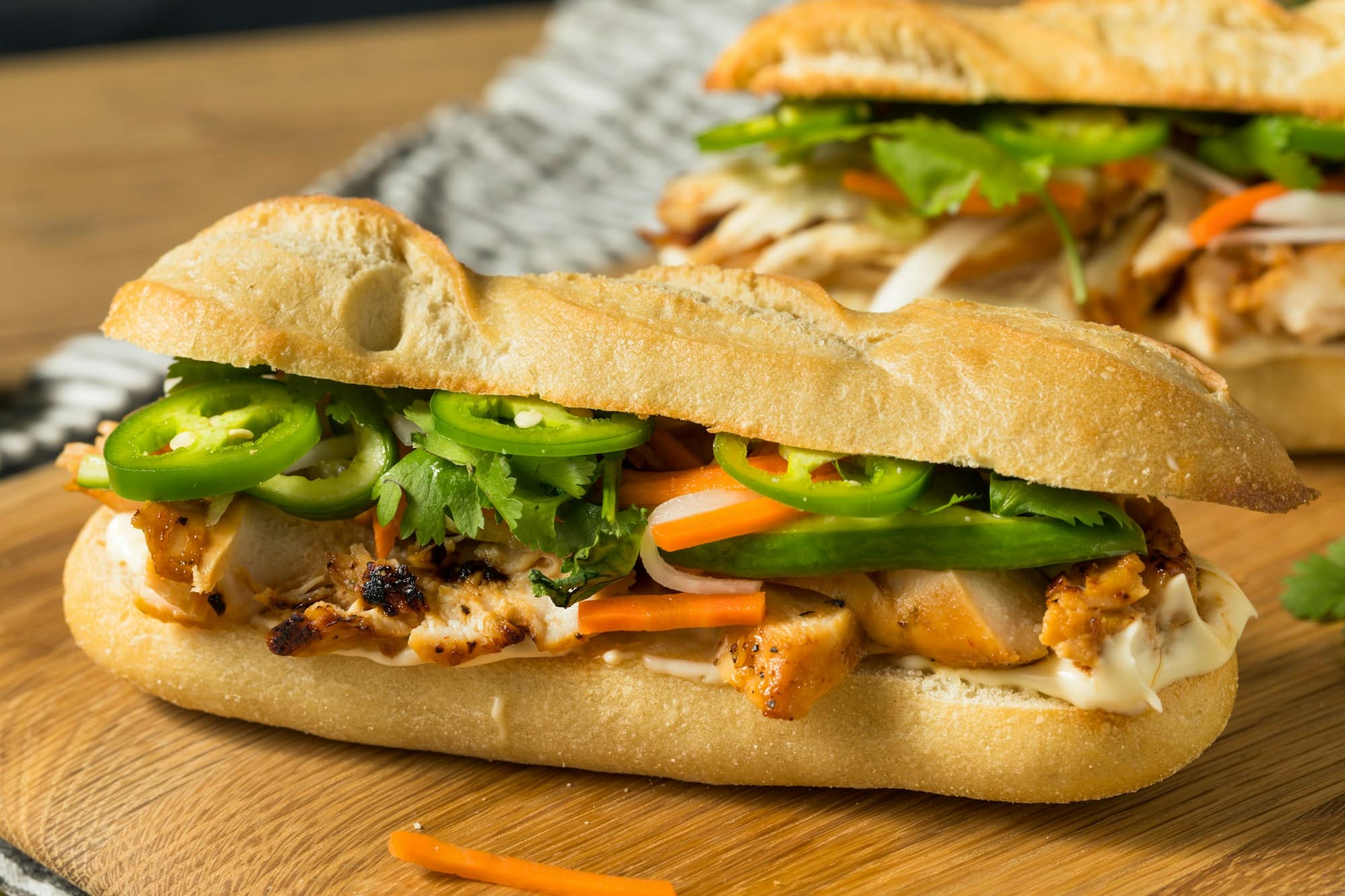In the world of Vietnamese cuisine, one standout is the Banh Mi, a sandwich that fuses Vietnamese and French culinary traditions. The sandwich typically contains meat, pickled vegetables, and an array of sauces. While there are many variations, a popular choice is lemongrass beef. In this article, we will guide you through the process to make your own Vietnamese lemongrass beef Banh Mi. We will also provide tips to ensure you get the best flavors out of your ingredients.
Understanding the Ingredients of a Vietnamese Banh Mi
Before we delve into the cooking process, it’s essential to understand the ingredients that make up a traditional Vietnamese Banh Mi. The Banh Mi is a delicate balance of flavors, textures, and ingredients that come together to create an unforgettable gastronomical experience.
Lire également : What Techniques Can You Use to Perfect a Gourmet Flan with Caramel Sauce?
The meat is a critical part of the Banh Mi. In this recipe, we will be using beef, but pork and chicken are also commonly used. The meat is usually marinated and cooked with different spices and sauces to give it a unique flavor. In this case, we will marinate the beef with lemongrass and garlic.
Next, we have the pickled vegetables. In most Banh Mi recipes, this means carrots and daikon radish pickled in a mixture of vinegar, sugar, and salt. These pickled vegetables add a tangy, sweet flavor that contrasts beautifully with the savory meat.
Dans le meme genre : Can You Create a Gourmet S’mores Dessert with Homemade Graham Crackers?
The sauce is another significant ingredient. A good Banh Mi will have a perfect balance of sweet, savory, and spicy sauces. For this recipe, we will make a garlic mayonnaise and a soy sauce glaze.
Finally, the bread. Banh Mi is served on a baguette, a nod to Vietnam’s French colonial past. The perfect baguette is light and fluffy on the inside and crispy on the outside.
Preparing the Lemongrass Beef
Now that we’ve discussed the ingredients, let’s start with the star of our sandwich — the lemongrass beef. To make the beef succulent and packed with flavor, you will need to marinate it for at least 30 minutes before cooking.
You will need beef slices, lemongrass, garlic, sugar, and soy sauce for the marinade. First, mix the finely chopped lemongrass, minced garlic, sugar, and soy sauce in a bowl. Then add the beef, ensuring that each slice is well coated with the marinade. Let it sit for a minimum of 30 minutes. However, the longer you let it marinate, the more flavorful your beef will be.
After marinating, heat a pan and cook the beef slices until they’re browned and aromatic. The result is a flavorful, tender lemongrass beef that will make your Banh Mi stand out.
Creating the Perfect Pickled Vegetables
While your beef is marinating, let’s get started on the pickled vegetables. As mentioned earlier, the usual choice for Banh Mi is pickled carrots and daikon radish. However, you can also add cucumber or other vegetables for a different twist.
To start, peel the daikon and carrots and cut them into thin, matchstick-sized strips. Then, in a separate bowl, mix together vinegar, sugar, and salt until fully dissolved. Add the carrot and daikon strips to this mixture and let them sit for at least one hour. The result will be a tangy, sweet, and crunchy complement to your savory beef.
Making the Sauces
The sauces are what bring all the flavors of the Banh Mi together. For the lemongrass beef Banh Mi, we are making two sauces: a garlic mayonnaise and a soy sauce glaze.
To make the garlic mayo, combine mayonnaise, minced garlic, and a touch of lime juice. Mix until well combined.
For the soy sauce glaze, simply mix together soy sauce, sugar, and a bit of cornstarch in a pan over medium heat. Stir until the sugar completely dissolves and the sauce has thickened. Both of these sauces will add a depth of flavor to your Banh Mi.
Assembling the Banh Mi
Once you’ve prepared your beef, pickled vegetables, and sauces, it’s time to assemble your Banh Mi. Start by slicing the baguette in half. Spread a generous amount of the garlic mayo on both sides of the bread. Then, layer the lemongrass beef on one side. Top with the pickled vegetables and drizzle with the soy sauce glaze. To add a touch of freshness, you can add sprigs of cilantro.
The result is a Banh Mi with a mouthwatering combination of flavors and textures: the savory lemongrass beef, the tangy pickled vegetables, the creamy garlic mayo, the sweet and salty soy sauce glaze, and the crisp, airy baguette. With this recipe, you can make a Vietnamese lemongrass beef Banh Mi that would rival any you’d find at a street stall in Vietnam.
Incorporating More Vietnamese Flavors
Now that you’ve got the basics of making a Vietnamese lemongrass beef Banh Mi, let’s expand on that knowledge. Vietnam is known for its distinct and vibrant flavors, and there are several ingredients you can add to bring more authenticity to your Banh Mi.
Fish sauce is a staple in Vietnamese cuisine. For a more authentic flavor, consider adding a splash of fish sauce to your beef marinade. It imparts a unique umami taste that enhances the overall flavor of the beef.
You’ve already mastered the art of making pickled vegetables, but another way to bring a crunchy element to your sandwich is by adding thinly sliced cucumber. It would provide a fresh and crisp contrast to the savory beef.
For those who enjoy a bit of heat, sliced jalapenos can be added. You can either include them with the pickled vegetables or place them separately on the sandwich.
Finally, you might want to consider adding a dipping sauce. Though not traditionally served with Banh Mi, a side of Vietnamese dipping sauce or ‘Nuoc Cham’ can provide even more flavor. It’s a simple mixture of fish sauce, lime juice, sugar, water, and optional chili.
Conclusion
The beauty of the Vietnamese lemongrass beef Banh Mi lies in the harmony of its ingredients. From the sweet and tangy pickled vegetables to the savory lemongrass beef, each component plays a role in creating a symphony of flavors. And while this recipe is simple, it does require some patience and preparation.
The marinade for the beef, the pickling of the vegetables, and the creation of the sauces are all steps that cannot be rushed. Each requires time to ensure that the flavors fully develop. But the end result — a sandwich that is a delightful interplay of flavors and textures — is well worth the effort.
We hope that this article has not only taught you how to make a Vietnamese lemongrass beef Banh Mi, but also inspired you to experiment with different flavors and ingredients. The beauty of cooking is that you can always adapt and modify recipes to suit your own taste. So don’t be afraid to use this recipe as a starting point and then make it your own.
Remember, cooking is not just about the end result. It’s about the journey and the joy of creating something delicious with your own two hands. We hope you find as much pleasure in making (and eating) this Vietnamese lemongrass beef Banh Mi as we do. Enjoy your culinary adventure!






